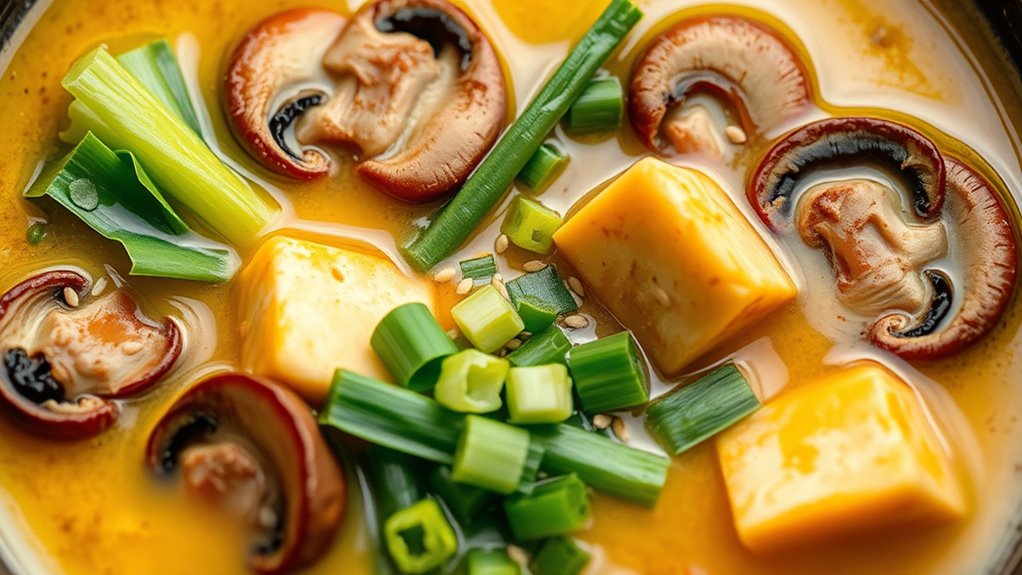To build a balanced vegan ramen, focus on selecting hearty plant-based proteins like marinated tofu with textures matching your desired mouthfeel. Use a flavorful broth enriched with umami boosters such as miso, seaweed, and mushrooms, simmered to develop depth. Shell out attention to noodles and vegetables for satisfying textures and balance. Combining these elements ensures a rich, comforting bowl. Keep exploring, and you’ll discover how each component can elevate your ramen to new heights.
Key Takeaways
- Use a variety of tofu textures, properly pressed and marinated, to balance protein flavor and mouthfeel.
- Incorporate umami-rich ingredients like miso, seaweed, and mushrooms to deepen broth flavor.
- Cook noodles al dente and add vegetables for diverse textures and a satisfying bite.
- Enhance broth richness with coconut milk, sesame oil, and layered seasonings for depth.
- Balance protein, broth, and textures to create a harmonious, flavorful, and satisfying vegan ramen.

Have you ever wondered how to enjoy a comforting bowl of ramen without any animal products? Achieving that perfect balance in vegan ramen means paying attention to three key elements: protein, mouthfeel, and broth depth. Each plays a essential role in crafting a satisfying dish that rivals traditional ramen. Let’s start with protein. Tofu is your best friend here, offering a versatile and hearty option. The trick is to choose different tofu textures to match your desired mouthfeel. Silken tofu adds a smooth, creamy element that melts into the broth, creating a silky texture. Firm or extra-firm tofu, on the other hand, provides a chewy bite that mimics meat’s density. To maximize flavor, press the tofu to remove excess moisture, then marinate it in soy sauce, garlic, and ginger before pan-frying or baking. This process enhances its taste and gives it a slightly crispy exterior, elevating your ramen’s protein profile. Incorporating AI-generated recipes can also inspire creative flavor combinations and innovative preparation techniques.
Tofu’s texture and marinade elevate vegan ramen’s flavor and protein.
Next, consider broth seasoning. The broth is the heart of your ramen, and its depth defines the overall experience. Start with a base of vegetable stock, enriched with umami boosters like miso paste, seaweed (such as kombu or wakame), and mushrooms. These ingredients contribute layers of flavor that mimic traditional meat-based broths. Don’t forget to season thoughtfully—soy sauce, tamari, or vegan fish sauce can add saltiness and complexity. Add a splash of sesame oil for richness, and finish with freshly grated ginger or garlic for zing. The key is to simmer these ingredients gently, allowing the flavors to meld and develop depth. The seasoning should be bold enough to carry the toppings but balanced enough to let each component shine.
Creating the right mouthfeel involves more than just protein and broth. The noodles are essential—they should be al dente, with a chewy texture that holds up to the broth’s richness. You might also consider adding vegetables like bok choy, shiitake mushrooms, or bamboo shoots for additional texture and freshness. These elements contribute to a multi-layered mouthfeel that makes each spoonful engaging. The broth’s thickness can be adjusted by adding a small amount of coconut milk or blended vegetables, which give it a velvety consistency. Combining these elements thoughtfully ensures your vegan ramen is not only flavorful but also satisfying in every bite.
In essence, building a balanced vegan ramen hinges on selecting the right tofu textures, seasoning your broth thoughtfully, and balancing mouthfeel through noodles and vegetables. When these components come together, you create a bowl that’s rich, comforting, and entirely plant-based—proof that vegan ramen can be just as delicious as its traditional counterpart.
Frequently Asked Questions
What Are the Best Plant-Based Protein Sources for Ramen?
When choosing plant-based protein sources for ramen, consider a variety of tofu options like firm or silken for different textures. Legume options such as chickpeas, lentils, or edamame also work well to boost protein content. You can add cubed tofu or cooked legumes directly into your broth, ensuring each bite is satisfying and nutritious. Mixing different tofu varieties and legume options gives your ramen a perfect balance of flavor and texture.
How Can I Enhance the Umami Flavor Without Animal Products?
Imagine transforming your ramen into a flavor-packed masterpiece. To boost umami without animal products, start with mushroom soy for depth and richness. Add dried seaweed to your broth—kelp or kombu work wonders—creating a savory, oceanic essence. Simmer these ingredients gently, letting their natural umami infuse your broth. The result? A vibrant, satisfying vegan ramen that teases the palate with every sip, full of layered, irresistible flavor.
What Are Some Tips for Achieving a Rich, Broth Depth?
To achieve a rich broth depth, start by simmering flavorful ingredients like miso paste and roasted seaweed. These add natural umami and complexity. Use a variety of mushrooms and vegetables for extra depth, and don’t forget to let the broth simmer slowly to develop full-bodied flavors. Stir in miso paste near the end to maintain its umami punch, and add roasted seaweed for a salty, savory boost.
How Do I Prevent the Noodles From Becoming Soggy?
Think of noodle preparation like timing a perfect song—overcooking ruins the rhythm. To prevent sogginess, cook your noodles separately, then rinse with cold water to stop the cooking process. Use serving techniques like adding noodles at the last minute or keeping the broth and noodles separate until ready to serve. This keeps your noodles firm and delicious, ensuring your ramen hits all the right notes every time.
Can Vegan Ramen Be Customized for Different Spice Levels?
You can easily customize the spice level in your vegan ramen by adjusting the amount of chili, sriracha, or hot sauce you add. For milder flavor adjustments, start with small amounts and taste as you go. If you want more heat, gradually increase the spice until it suits your preference. This way, you create a personalized ramen experience, balancing flavor adjustments and spice customization for every bite.
Conclusion
As you take your first sip of this balanced vegan ramen, it’s like discovering a hidden garden—delicate yet full of depth. Just like cultivating a thriving oasis takes patience and care, perfecting the broth, protein, and mouthfeel demands attention to detail. Remember, every ingredient plays a essential role, much like each plant adds to the garden’s beauty. Keep experimenting, and you’ll craft a bowl that’s both nourishing and extraordinary—your own culinary sanctuary.










